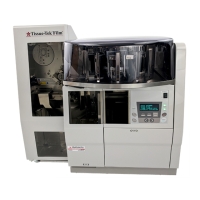Revised 08/08/2013 4.1
Section 4
SLIDE HANDLING
Handling of Coverslipped Slides
Removal of Immersion Oil
Immersion oil can be removed from a coverslipped
slide by dipping the slide into xylene for a few seconds,
draining, and wiping the slide dry with a soft, nonabrasive,
low-lint cloth.
Cleaning the Coverslipped slides
Fingerprints can be removed from the coverslipped
slides using a soft, non-abrasive, low-lint cloth.
Writing on the Coverslipped Slides
If you wish to mark a suspicious area on the slide, a
permanent, soft-tipped marker can be used. Transparency
markers work the best; however, many other permanent
markers can also be used. To remove the markings,
gently wipe the slide with a soft, nonabrasive cloth
dampened with alcohol.
Removal of the Coverslipping Film
The unique properties of the coverslipped film make it
easy to remove the coverslipped film from the slide as
compared to a glass coverslipped slide.
This section proposes three methods for removing the
coverslipping film. It should be noted that removal of the
coverslipping film is usually not required, and is an
indication that the operating instructions found in the
Operating Manual were not adhered to.
“Method A” is the most common method used to repair
a film coverslipped slide.
“Method B” results in retaining the original piece of
coverslipping film. This would be necessary if any
specimen is possibly attached to the Film and not to the
slide.
“Method C” is used to completely remove the
coverslipping film. Removed coverslipping film cannot be
reused. This method should be used if there are no
specimens adhering to the film.
Equipment and Reagents Needed
Coplin jars
Acetone
Absolute alcohol
Xylene-reagent grade
Forceps or teasing needle
Method “A” has been tested using cytology, histology,
and hematology specimens. The film is removed with
virtually no damage to the specimen and the slide can be
restained and/or recoverslipped.
1. Place the coverslipped slide into a coplin jar filled with
acetone. Allow it to remain in the jar for three to five
minutes. Remove the slide and, using a pair of
forceps or a teasing needle, lift the coverslipping film
off of the slide. A thin layer of mounting medium will
remain on the slide.
NOTE: After three minutes of exposure to the acetone, the
film will still be attached to the slide and must be gently
lifted off. This limits the direct exposure of the stained
tissue to the acetone, reducing the amount of
depolarization. This shorter time period should be used if
the slide is just being recoverslipped. After about five
minutes of exposure, the film falls off the slide by itself.
However, the tissue is not in direct contact with the
acetone, and the stain will fade. This is not a problem if
the tissue is to be decolorized and restained.
2. Transfer the slide through three changes of absolute
alcohol for 30 seconds each to remove the acetone
residue. Follow with three changes of xylene for one
minute each to remove the mounting medium.
3. If the slide is to be immediately recoverslipped,
remove it from the last xylene bath and immediately
process it on the Tissue-Tek Film Coverslipper. If the
specimen is to be decolorized and restained, remove
the slide from the last xylene bath and place it into a
fourth change of absolute alcohol for 30 seconds.
Decolorize and restain the specimen as desired.
Method “B” results in retaining the original piece of
coverslipping film. This would be necessary if any
specimen is possibly attached to the Film and not to the
slide.
1. Immerse the slide in xylene for approximately one
minute to reactivate the film resin.

